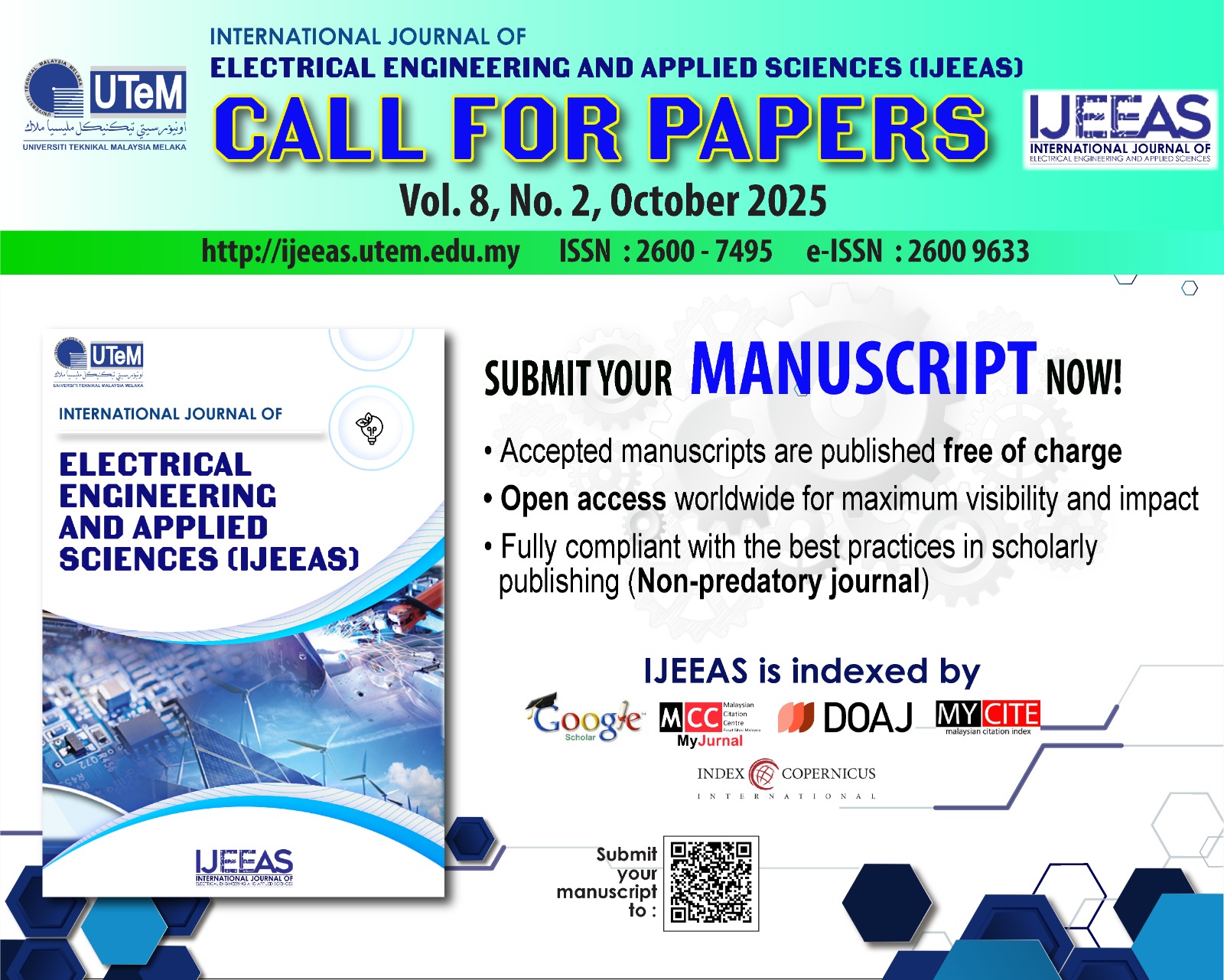Fuzzy Logic Collision Avoidance for Autonomous RC Car Follower Utilizing Monocular Camera as Distance Approximator
Keywords:
fuzzy logic, vision system, autonomous rc carAbstract
This paper present the collision avoidance method of a car follower by using fuzzy logic. The distance between the Lead Vehicle (LV) and Follower Vehicle (FV) is approximated using machine vision. Firstly, unit test is performed to check the reliability of the vision system approximation. Once calibrated, the system is validated by integrating the finalized algorithm to the developed prototype. The experiment comprised of testing the capability of the prototype to avoid collision with the lead vehicle when the lead vehicle stops abruptly in two conditions; straight path and curved path. The results shows that the prototype was able to avoid collision in most cases and the of set classifier improves mean percentage error of distance detection and prevented false trigger of the braking system.Downloads
References
A. Pfordten, “Lembaga Lebuhraya Malaysia (LLM) – Caretaker of The Highways,” Jurutera, vol. 2014, pp. 9–11, July 2014.
MIROS, “General Road Accident Data in Malaysia (1997 – 2016),” 2016. [Online]. Available: https://www.miros.gov.my/1/page.php?id=17
Bernama, “5,083 Road Accident Deaths Recorded from Jan-Sept 2017,” New Straits Times, Nov 2017. [Online]. Available:https://www.nst.com.my/news/nation/2017/11/302157/5083-road-accident-deaths-recorded-jan-sept-2017.
V. Babulal, “Number of Fatal Road Accidents up in 2016, More than 7,000 Lives Lost,” New Straits Times, Jan 2017. [Online]. Available: https://www.nst.com.my/news/2017/01/205090/ number-fatal-road-accidents-2016-more-7000-lives-lost
P. S. Mooi, “Asian Highway Development Issue,” The Ingenieur, pp. 20–28, April 2016.
M. Bertozzi, A. Broggi, and A. Fascioli, “Vision based Intelligent vehicles: State of the Art and Perspectives,” Robotics and Autonomous Systems, vol. 32, no. 1, pp. 1-16, 2000. [Online]. Available: http://www.sciencedirect.com/science/article/pii/S0921889099001256
C. Jiangwei, J. Lisheng, G. Lie, W. Rongben, and L. Bibing, “Study on Method of Detecting Preceding Vehicle Based on Monocular Camera,” in 2004 IEEE Intelligent Vehicles Symposium. IEEE, 2004, pp. 750–755.
W. Zheng. (2015) Self Driving RC Car.[Online].Available:https://zhengludwig.wordpress. com/projects/self-driving-rc-car/
G. Bradski and A. Kaehler, Learning OpenCV, 1st ed.O’Reilly, 2008.
I. Saleh and W. Rahiman, “The Effect of Illumination Compensation Methods with Histogram Back Projec- tion for Camshift Application,” Journal of Fundamen- tal and Applied Sciences, vol. 9, no. 6S, pp. 618–631, 2017.
E. Rich, K. Knight, and S. B. Nair, “Heuristic Search Techniques,” in Artificial Intelligence, 3rd ed. Tata McGraw Hill Education Pvt. Ltd., 2010, ch. 3, pp.52–76.
P. Verkhogliad. (2012) Fuzzy Logic Example #2. [Online].Available:https://petro.tanrei.ca/fuzzylogic/fuzzy_mehaan_joy.html1
G. Meehan and M. Joy, “Animated Fuzzy Logic,” Journal of Functional Programming, vol. 8, no. 05, pp. 503–525, 1998.
M. Negnevitsky, Artificial Intelligence: A Guide to Intelligent Systems, 3rd ed. Pearson Education, 2011.
H. Roubos and M. Setnes, Compact Fuzzy Models and Classifiers through Model Reduction and Evolutionary Optimization, 2nd ed. CRC Press, 2001, pp. 31–59.
N. Siddique, Intelligent Control: A Hybrid Approach Based on Fuzzy Logic, Neural Networks and Genetic Algorithms. Springer, 2013, vol. 517.
O. Cordon, F. Herrera, F. Hoffmann, and L. Mag- dalena, Genetic Fuzzy Systems: Evolutionary Tuning and Learning of Fuzzy Knowledge Bases. World Sci- entific, 2001, vol. 19.
G. R. Raidl and J. Puchinger, Combining (Integer) Linear Programming Techniques and Metaheuristics for Combinatorial Optimization. Springer, 2005, vol.3636.
Downloads
Published
How to Cite
Issue
Section
License
Authors who publish with this journal agree to the following terms:
- Authors retain copyright and grant the journal right of first publication with the work simultaneously licensed under a Creative Commons Attribution License that allows others to share the work with an acknowledgement of the work's authorship and initial publication in this journal.
- Authors are able to enter into separate, additional contractual arrangements for the non-exclusive distribution of the journal's published version of the work (e.g., post it to an institutional repository or publish it in a book), with an acknowledgement of its initial publication in this journal.
- Authors are permitted and encouraged to post their work online (e.g., in institutional repositories or on their website) prior to and during the submission process, as it can lead to productive exchanges, as well as earlier and greater citation of published work (See The Effect of Open Access).







